Trapani is the city of salt, couscous and churches.
An ideal starting point for exploring western Sicily, Trapani sits on a crescent-shaped stretch of coast, right where the Tyrrhenian Sea meets the Mediterranean.
Trapani offers visitors brilliant glimpses of history, ancient traditions and a perfect cuisine for sea-food lovers.
Here is what to do and where to go to enjoy the city like a true local.

Trapani like a local

Phoenicians, Romans and Normans have left their traces in the town planning, monuments and habits of the local people, industrious traders and fishermen.
There is so much to discover, from the strong flavour of local version of pesto to the baroque beauty of churches and palaces: Trapani is an ideal destination for both classic urban tourism and seaside tourism, thanks to its proximity to the Egadi archipelago.
The following is therefore a list with our suggestions to make you experience the city like a genuine Sicilian, to discover those little gems that make a visit special.
Here are the 10 things to do in Trapani to experience the city like a local: an itinerary between the sea and the old city centre, the best beaches of the Egadi Islands, traditional foods and the village with an unmissable view.
10. Trapani like a local. Visiting the local saltworks
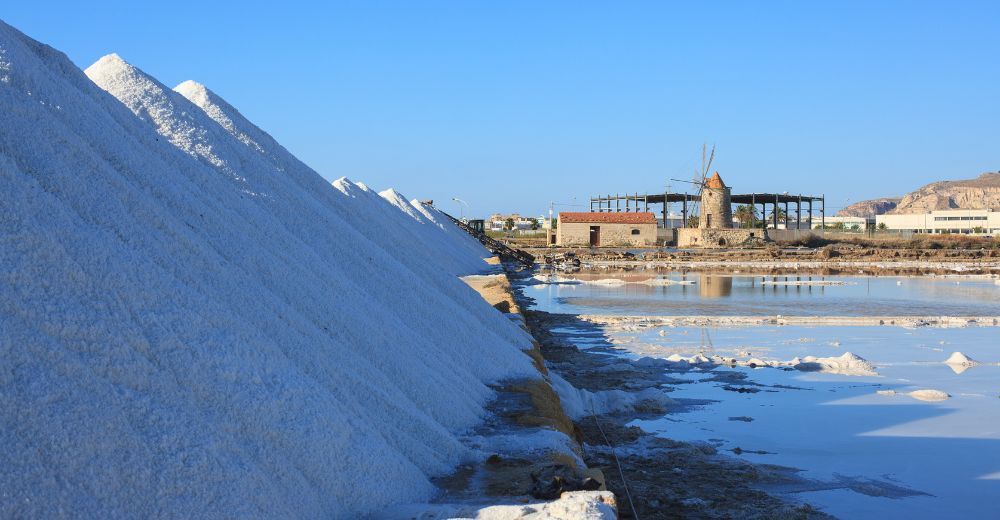
Pink flamingos, dramatic sunsets and sleek silhouettes of mills.
It looks like a medieval "tongue twister", but these are the actual attractions you can visit in the Trapani and Paceco Nature Reserve, comprehensive of the saltworks.
This reserve is a gem not far from Trapani, a place to take memorable photographs and where to connect to rural, old-fashioned side of Sicily.
The saltworks of Trapani and Paceco extend over an area of just under 1000 hectares and are protected by the WWF, as they are on the migratory route of numerous bird species. Here sea salt is still produced - only privately though - continuing a tradition born with the Phoenicians and then developed by the Normans and Frederick II of Swabia.
Little has changed in the traditional extraction method: lots of sun, manpower and the use of the iconic mills. The mills were extremely important and today can be considered the scenographic symbol of the saltworks: they were used to pump water from one basin to another, or to grind salt crystals.
The saltworks are a paradise for birdwatchers: this is the favorite destination for various species of birds, including herons, pink flamingos and the avocet.
You can explore the salt flats every day, from morning to sunset, on your own or with a guided tour. We recommend taking part in a guided tour as there is so much to learn about salt processing and the history of this corner of Sicily (for information on guided tours, just visit the reserve's official website). Also don't miss the privately run Salt Museum in Nubia, which exhibits ancient tools related to salt processing, photos and ancient documents.
The saltworks can be reached by bus with line 30 (about 20 minutes), on foot from the center of Trapani (about 1 hour), or with a guided tour helping with the logistic The Visitor Center of the reserve is located at the Maria Stella mill.
9. Walking between sea and historical centre
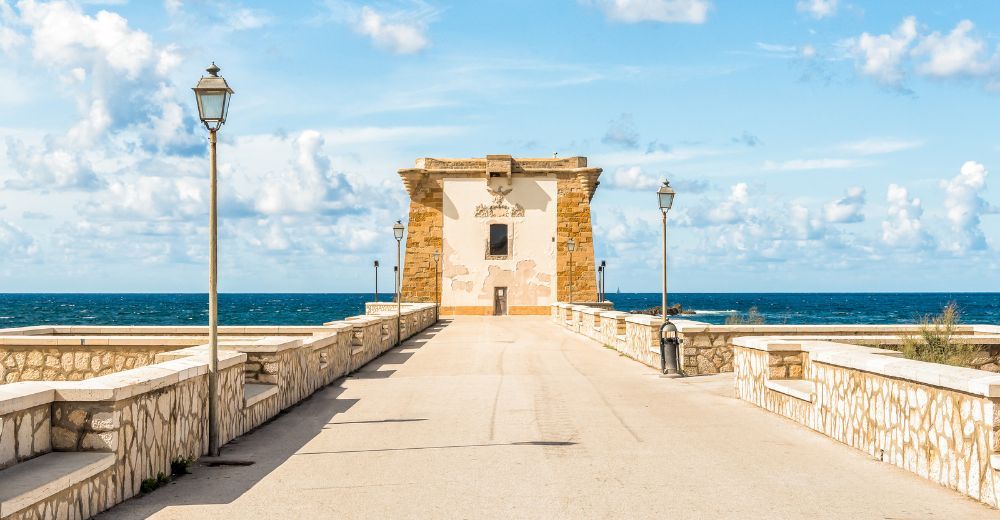
The historic center of Trapani is a tangle of narrow streets with ancient pastel-coloured buildings and churches, which suddenly explodes into a beautiful seafront.
Start your tour from the extreme tip of Trapani, where the Tyrrhenian Sea and the rest of the Mediterranean meet. Here is the Torre di Ligny, a 17th-century defensive fortress now housing the Civic Museum. The museum is very interesting, exhibiting prehistoric objects and finds recovered from the Trapani seabed, including Roman and Greek ships and a beautiful bronze helmet. Do not miss the view from the terrace.
For another panoramic point, walk to the nearny Villino Nasi.
Now walk back towards the proper city center, walking along the coast to the Piazza del Mercato del Pesce, a place full of life where the fish-market is located, perfect for mingling with the locals doing their shopping.
Go back slightly to walk along Corso Vittorio Emanuele, the city promenade with shops and restaurants, leading you to the Duomo (the San Lorenzo Cathedra, definitely worth visiting) and the Palazzo Senatorio, the local city hall. Right next to this building you will find the Clock Tower, with the ancient astronomical clock.
If you want to see one of the most loved churches by the people of Trapani, deviate from Corso Vittorio Emanuele and walk a few minutes to the Church of Purgatory, where you can see 20 sculptural groups relating to the Passion of Christ which are carried in procession on Good Friday (the famous "Processione of the Mysteries of Trapani"). This religious event makes Easter an ideal time to travel to Trapani and get to know the locals.
Finally, walk around Palazzo Ciambra, also known as the Palazzo della Giudecca, representative of the old Jewish quarter of the city.
8. Swimming in the turquoise Egadi sea
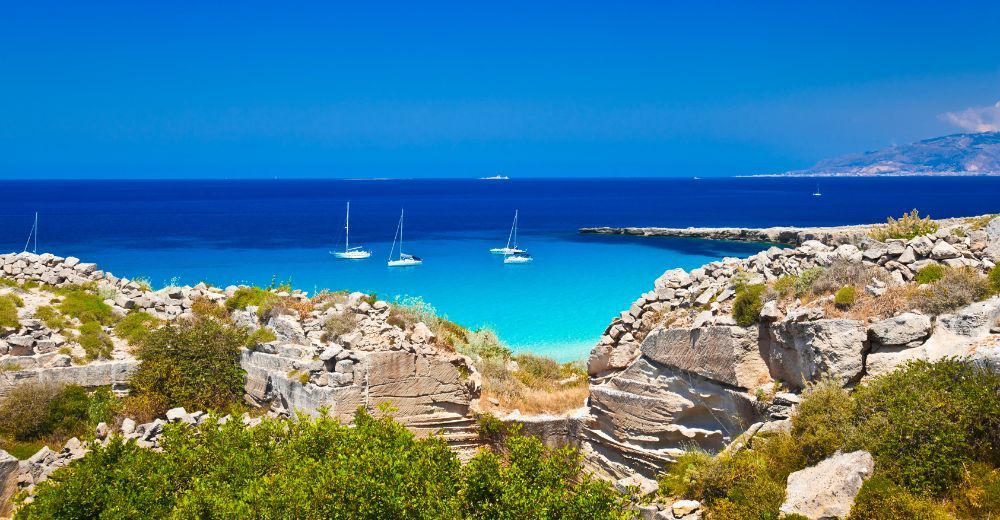
The Egadi sea is probably the best in the whole of Sicily.
The people of Trapani can enjoy a scenery worthy of the Maldives… just a stone's throw from home.
The Egadi archipelago is mainly formed by the islands of Levanzo, Favignana and Marettimo, which offer beaches, hidden coves and a wonderful turquoise sea.
If you are in Trapani between June and September, a visit to at least one of the islands is a must for a dip in the sea and some activities (visit to caves or to a tuna fishery, scuba diving).
Favignana is the queen of the Egadi and the most popular island of the archipelago. Its Cala Rossa is simply unmissable, one of the most renowned beaches in Italy. Once you arrive at the marina, we recommend you to rent a bicycle or scooter to stop at the various beaches (in addition to Cala Rossa, there are Cala Azzurra, Lido Burrone and Calamone) and visit the former tuna-fishery of the Florio family, one of the symbols of the island of Sicily itself.
Levanzo is the smallest of the Egadi but it is worth a visit if you are looking for relaxation and contact with nature. Do not miss a visit to the Grotta del Genovese (a cave where you can admire Palaeolithic rock graffiti with a guided tour) and dive to 30 meters to see the wreck of a Roman cargo ship loaded with amphorae.
Marettimo is the most distant island from the coast and is a popular destination for expert divers who sneak into the numerous caves in the area (not to be missed is the Grotta del Toro).
Getting to the Egadi from Trapani is quite easy using the many ferry companies: Liberty Lines, Torre Lines and Siremar. Book online or at the ticket office: you can make the journey by ferry, bringing onboard your own vehicle. The cost for a single passenger varies between €10 and €20.
Book boat tour to Favignana and Levanzo7. Tasting the local cuisine
If you love fish cuisine, you will feel at home in Trapani.
It's difficult to find a gastronomic tradition that is based on sea products as much as that of Trapani.
Trapani's cuisine is also famous for its contamination with North Africa, creating a delicious blend of land and sea products.
The main dish of Trapani is couscous.
The secret of an excellent Trapani-style couscous lies in the quality of the fish used for the broth that gives the flavour (in which local chefs put redfish, grouper and also scampi and prawns) and in the semolina, laboriously worked to separate the grains before getting steamed. There are many variations, but almost all the taverns in Trapani offer the classic version: try the one at the Cantina Siciliana restaurant in the historic center and you won't regret it.
If you are in Trapani in September, don't miss the Couscous Fest, a festival dedicated to this dish in all its variations.
Among the first courses you absolutely must try the busiate al pesto trapanese (a traditional pasta seasoned with the local pesto, a strong red sauce made with garlic, tomato sauce and almonds) and the spaghetti with tuna bottarga.
For true lovers of the sea flavours, our first suggestion is obviously to order a portion of fish broth ("brodo di pesce"), one of Trapani's specialties.
The best way to start a meal in Trapani is to try the series of "antipasti di tonnara" ("tuna starters"), all prepared with local bluefin tuna: taste the tuna bottarga, or the bluefin tuna in salt, the ventresca in oil or the ficazza (sort of tuna salami).
The second courses to be tasted in the trattorias are obviously based on fish: you absolutely must try the succulent swordfish and tuna steaks, of which you can also eat the delicious meatballs.
Trapani street food, on the other hand, offers delicacies to be enjoyed while strolling in the historic centre, such as pane cunziato (a big slice of bread dipped in oil and seasoned with anchovies, cheese, tomato and oregano), arancine (the famous rice balls) and panelle (small rectangles of fried batter made from chickpea flour). Try all three and choose your favourite!
The local desserts align with the Sicilian tradition: don't miss the cannoli filled with delicious ricotta (or the less crunchy cousins called fried cassatelle), the sweet cassata and the true Sicilian breakfasts with brioche and gelato.
6. Get surprised at the Museum of Illusions
Do you want to be fooled by your own mind?
If you are interested in this type of experience then the Museum of Optical Illusions (known as "M.O.O.I") in Trapani is perfect for you.
A little gem opened in the heart of the historic center, founded by a Sicilian aeronautical technician who wanted to create an original attraction in his city.
The rooms of the museum are set up with "visions" that deceive the visitor, leaving adults and children amazed. Still objects giving the illusion of movement, rooms with impossible proportions, structures that have different shapes depending on your perspective and tricks that play with the "weakneasses" of your mind.
The illusions you will encounter in the museum involve different worlds, from art to psychology, from pure "magic" to physics.
The Museum of Optical Illusions is therefore ideal for spending a couple of hours of fun, following the guided tour (the only way to visit it as you need the knowledge of the museum employees to decipher many of the illusions).
The museum is quite photogenic and you can create very original shots to share with friends.
The M.O.O.I is only open on Saturdays and Sundays and to visit it you need to book the guided tour in advance. The cost of the ticket is around €13 and children under 12 must be accompanied by an adult.
5. Visiting the Tonnara di Scopello
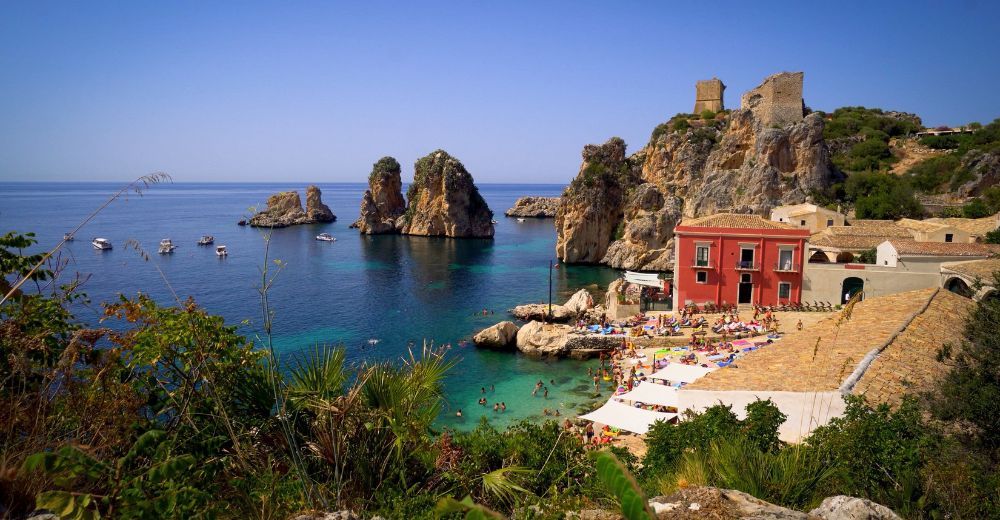
The picturesque Tonnara di Scopello is one of the few remaining places where you can see the history of the Mediterranean and the tradition of tuna fishing.
This old tonnara is an invaluable open-air museum.
A visit to the tonnara museum feels like looking into a window on the world of Sicilian fishermen: the same fishermen who have handed down secrets and methods of tuna fishing for centuries. In the museum you can find original boats and tools, as well as the warehouses where the tuna was kept after the slaughter.
The old houses where the fishermen lived and slept have been transformed into a hotel with beautiful rooms with sea view, which can be booked on the official website of the tonnara.
Guided tours last about 30 minutes. Afterwards you can visit the external common areas of the tonnara.
By paying €4 for the entrance ticket you can visit the fishery but also explore the rocky and spectacular Faraglioni beach. Attention, places are limited to avoid overcrowding so it is better to arrive in Scopello very early, perhaps visiting during the low season (May-June, September-October).
The village of Scopello is quite small, with a few houses, shops and restaurants that lives off the tourism of the tonnara and the nearby Zingaro Nature Reserve.
You can get to the Tonnara di Scopello by car from Trapani (about 40 km) or by sea. Parking is sometimes quite difficult to find and the cost to park a car for a whole day can be as high as €20. After parking you will have to walk for a kilometre to get to your destination.
4. Exploring the tiny village of Erice
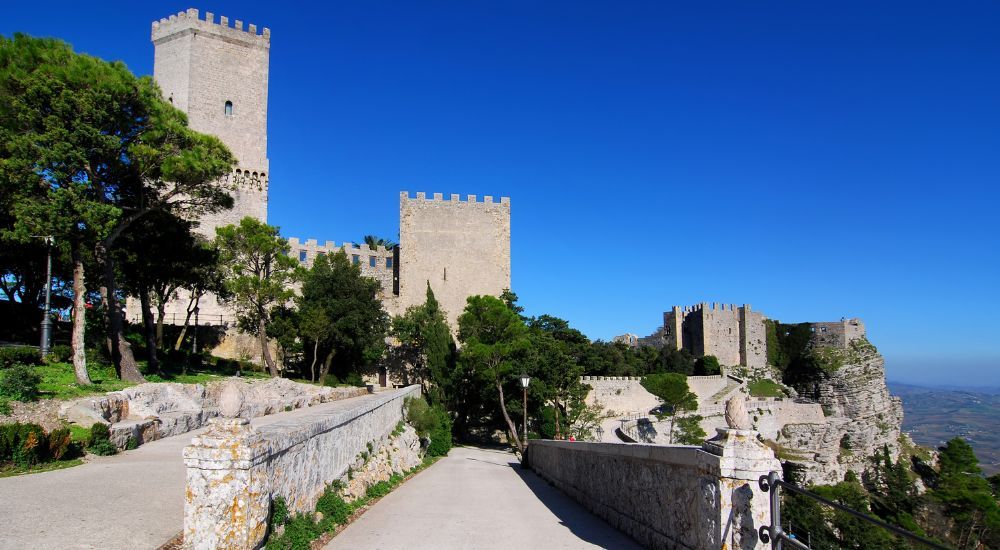
Erice dominates the Gulf of Trapani from a height of 751 metres.
Exploring this village is a pleasure for the eyes: you can appreciate the blue of the sea and the green of the trees, the urban density of Trapani and the iconic peak of Monte Cofano.
A well-planned afternoon and evening are enough to enjoy Erice, but you will certainly be able to spend more time in such an authentic village full of panoramic points and ancient buildings.
There are several attractions and churches to visit.
Start from the Madrice Church at Porta Trapani, built in the 4th century AD. to distance the locals from the cult of Venus Ericina and get closer to Christianity. Climb the 28-metre-high bell tower to appreciate the fantastic panorama.
Then get lost among the slippery stone alleys that all climb towards Piazza Garibaldi: stop in the small craft shops and in the bars and restaurants along the way to buy some souvenirs and try the local food.
Walking southwest, you pass through the Giardino del Balio and then through the Torretta Pepoli, to get to the beautiful Castello di Venere.
This castle is a Norman fortress built on a temple dedicated to Venus (among other things, the protector of sailors). By paying a €4 ticket, you can enter the castle and also see the Roman and medieval archaeological remains, and enjoy the birds-eye view.
If you are in Erice you absolutely must eat the typical dessert of this town, the famous Genovese di Ericina (also called simply "ericina"), a delicious brioche filled with boiling custard cream: try it at Pasticceria San Carlo and you will be amazed by its taste.
To get to Erice from Trapani you can choose the funicular (parking for a fee in Via Capua and taking the cable car for about 10 minutes at a cost of €10 return), by bus (about 40 minutes) or with your car (about 30 minutes from the center of Trapani climbing up a winding but scenic road).
Book day trip to Erice3. Aperitivo with a view
When the sun starts to set, giving off a sparkling warm glow, you know it's time to find a nice spot to enjoy a relaxing aperitivo with a view.
Locals love heading to the Porto Peschereccio area, a peaceful and very characteristic location a stone's throw from the historic centre. There are plenty of venues to drink a cold beer ora a glass of wine with a backdrop of moored boats and the sunset on the pier.
Linger until dinner and indulge in an excellent fish feast. Given the incredibly fresh catch, you might even feel adventurous enough to try some raw seafood.
For those who can't get enough of the sea, beach clubs with attached bars and restaurants and terrace kiosks overlooking the Tyrrhenian Sea are the ideal choice. Hangouts between Trapani and the province boast a retro and Mediterranean vibe or a cool and contemporary appeal.
2. Visiting the fish market
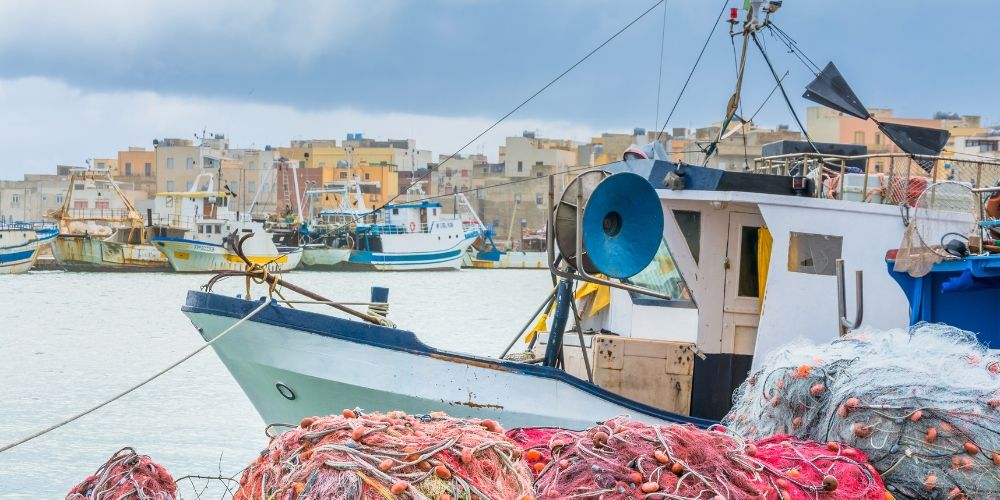
A loud chatter in the Sicilian dialect welcomes those who visit Trapani's ancient fish market.
The rhythmic call that distinguishes sellers in Sicilian markets, the so-called 'abbanniata', is an art form in its own right. Each vendor sings about the freshness of their stall, describes what's on display, and declares the selling price, all in a nearly musical rhythm.
It's a place of great popular charm. Stop by not only if you need to buy the catch of the day but also just to take a stroll and get a taste of everyday life in Trapani.
The market is almost at the tip of the peninsula that embraces the city, in a maze of alleys just a stone's throw from the sea and with a view of the mighty Colombaia Castle, the medieval fortress on the small island facing the port.
Prepare for a sensory overload of smells, colours and sounds, a vibrant tapestry of life that's a true feast for the senses. The best time to visit is early morning, between 7 and 9.
1. Attending the local film festival
Trapani is hosting the only major cinema festival in western Sicily, the newly established Trapani Film Festival. Now in its second edition, this celebration of the seventh art burst the city's summer events calendar with creativity.
Launched in 2023, the initiative aims to be a melting pot of audiovisual culture and a meeting point for international artists and producers.
The 2024 edition is scheduled to take place from June 20 to 23 at Casina delle Palme, an Art Nouveau gem commonly referred to by the locals as 'chalet'.
During the four-day event, spectators will have the opportunity to immerse themselves in the exciting screenings of the films in competition, meet the artists up close, and enjoy unforgettable musical performances.
Tickets are available on the official website of the Trapani Film Festival, so don't miss the chance to experience the enchantment of cinema in Trapani.
About the author
Written on 22/04/2024


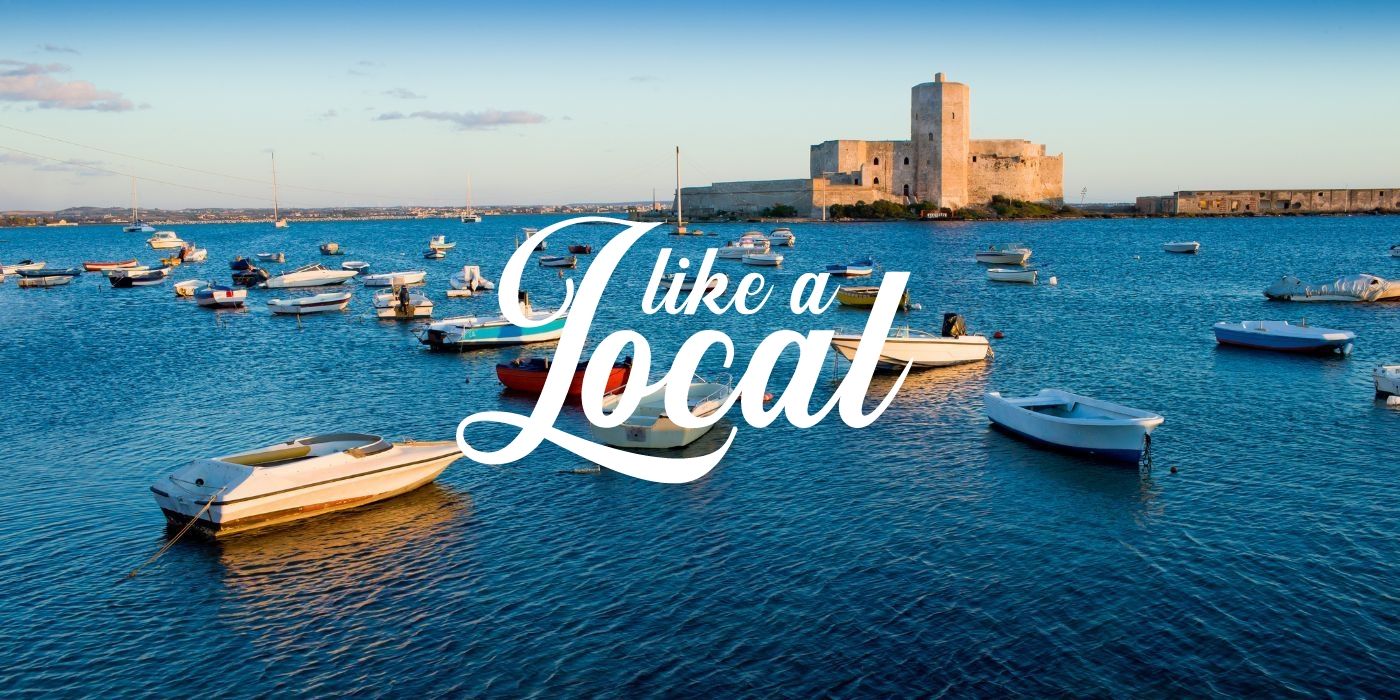
Fabrizio Mariani
Do you want to visit Trapani like a local? Then check out 10 things to get the best out of the city.